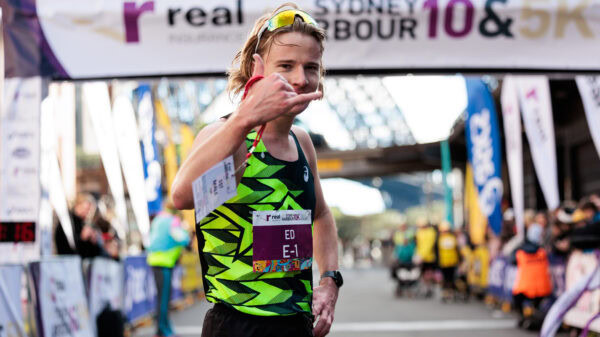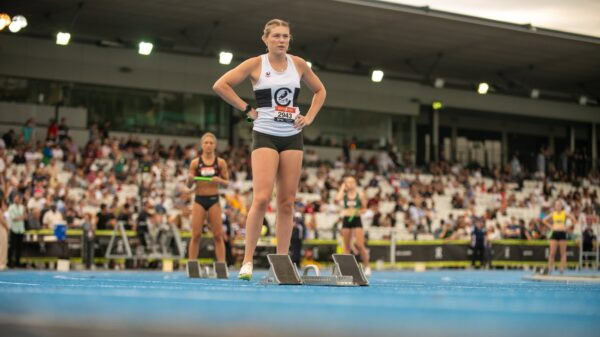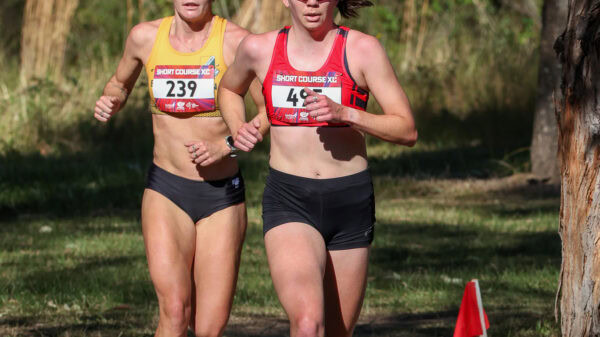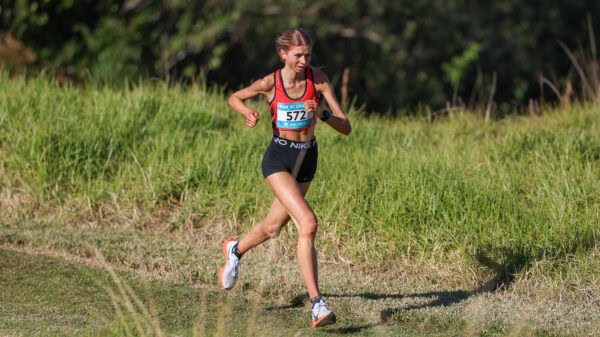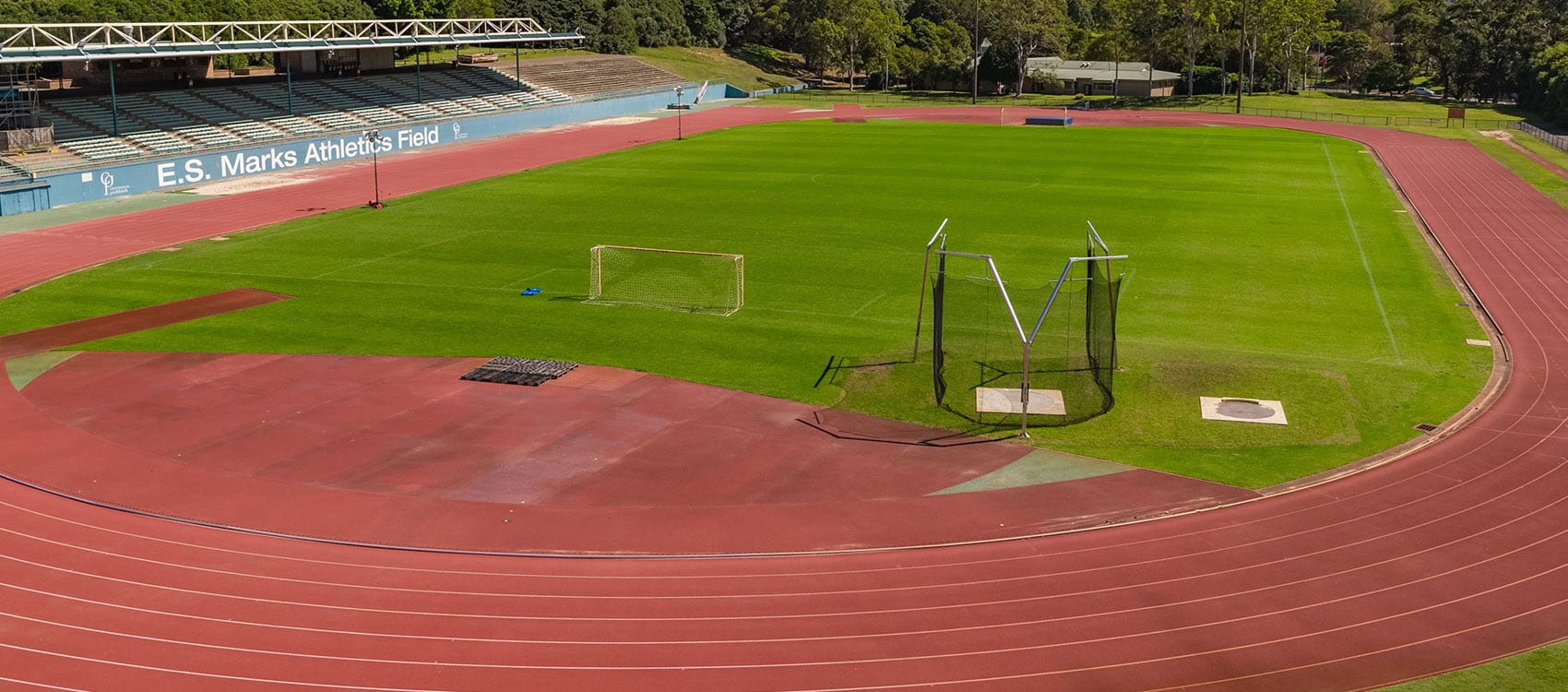That’s the question on my mind with this weekend’s Sydney Track Classic being held at the historic ES Marks Athletics Field instead of the best venue in the Harbour City.
It has been 30 years since ES Marks in Sydney’s eastern suburbs was replaced by Sydney Olympic Park Athletic Centre as Sydney’s premier athletics venue. The Homebush venue, originally named Sydney International Athletics Centre, opened with the hosting of the 1994 National Championships.
Before that, for almost half a century since a cinder track was laid at ES Marks in 1947 it was, as a sign that used to adorn the venue stated, the Home of Athletics in NSW. The venue dates right back to 1906, with its 1956 built concrete grandstand elevated metres above the track surface.
The track records were essentially frozen in time when the sport moved to SOPAC and show a glimpse back into the past of Australian athletics, with the likes of Tim Jackson’s (a windy 10.00 second 100m clocking), Melinda Gainsford-Taylor and Jane Flemming holding some of the best marks at the venue. It’s also the venue where World Athletics President, Sebastian Coe, had the last victory of his career over 800m in a 1990 Commonwealth Games warm-up meet.

Two years ago ES Marks was a relic of the past, having been fully resurfaced only once in the prior 30 years and seldom used for competition outside of school carnivals. It’s since had a $4.8m makeover, removing some of the concrete-cancer stricken grandstand and upgrading the lighting to a level of 200 lux (as a photographer, thankfully Saturday is an afternoon meet finishing in the twilight – 500 lux is a minimum standard for TV broadcast in the evening so it would be poor lighting were the meet to go longer). 
However, it’s a curious choice of a venue in comparison to using SOPAC, one of Australia’s best venues. ES Marks SOPAC Opened 1906 1994 Australian Championships hosted 6: ’62, ’68, ’73, ’80, ’87, ‘91 12: ’94, ’95, ’96, ’04, ’05, ’06, ’13, ’16, ’17, ’19, ’21, ‘22 Most recent major meet 1994 Mars Challenge 2023 Chemist Warehouse Sydney Track Classic Venue capacity 8,000 (1,000 in covered grandstand) 13,000 (5,000 in covered grandstand) Surface Rekortan M Rekortan M99 World Athletics certification Class 2 facility Class 1 facility Warm up track No Full size warm up track Permanent catering No Kiosks in grandstand Permanent scoreboard No Yes, located above 200m bend Parking None 10,000 on-site car parks within Sydney Olympic Park Public Transport Light rail or buses along Anzac Parade.
Free public transport is included within event ticket purchase.Train station and buses Event this weekend Sydney Track Classic Little Athletics NSW Championships Listing on Athletics Track Directory Ranked 8th in Australia’s Favourite Athletics Track 2021 Ranked 3rd in Australia’s Favourite Athletics Track 2021
We asked Athletics NSW President, Matthew Whitbread, about the choice of venue in an interview last December where we explored that state of Australian athletics two years after the merger proposed by Little Athletics Australia and Athletics Australia failed. “The return to ES Marks is a deliberate ANSW strategy to enhance the STC as an event.”Matthew Whitbread, Athletics NSW President
“The return to ES Marks is a deliberate ANSW strategy to enhance the STC as an event. If the Athletics community turns up to ES Marks and supports the STC in the same numbers they did this year [2023] at SOPAC, we will sell out the venue and the atmosphere will be absolutely electric for both the crowd and the athletes,” he said.
“Unfortunately, unless there are over 10,000 people at SOPAC, there will not be the same atmosphere. We are drawing inspiration from the success of the AFLW in Sydney which built strong and vibrant communities for the sport around North Sydney Oval and Henson Park, as well as the success of the NRL in returning games to spiritual home suburban grounds.
“We think that is the right strategy and we’d encourage everyone to get to ES Marks and support the STC in 2024 as they did at SOPAC this year,” Whitbread said.
I feel a strong sense of nostalgia in the meet being at ES Marks and I’m looking forward to travelling to it from Melbourne to be behind the camera lens. It’s a venue full of a range of memories for me, but particularly:

- As the venue of the first big-time athletics meets I ever attended, from 1992 to 1994. I have vivid memories of the likes of Dean Capobianco beating Darren Clark in a classic 400m contest, Cathy Freeman beating Melinda Gainsford, Simon Doyle setting an Australian 2000m record and Tim Forsyth and Simon Arkell soaring into the air in the high jump and pole vault. The venue was electric – the poor vantage points from parts of the grandstanding causing everyone to rise from their hard bench seats in anticipation to properly see the finishing line.
- For most of the period that I ran, through my teens into my early 20s, this was my home every Tuesday and Thursday night for training, surrounded by a wonderful community of characters.
- The only times I’ve taken photos at ES Marks were very early in my time behind the camera, back in 2006 and 2007 for local interclub meets. On one of those occasions a number of my former training partners set up a fairly solid 5000m, with a young Ryan Gregson breaking the Australian U18 record in finishing second.

From the archives:
November 2007: Gregson Eclipses 5000m Record
November 2007
17-year-old Ryan Gregson continued his record breaking season, setting a new Australian U18 5000m record with a run of 14:14.35. >> Read more
The recent Sydney Milers Meet at The Crest, where Cameron Myer ran the fastest 1500m ever by an Australian in Australia, showed what can be achieved in creating atmosphere with a relatively small number of spectators. However, it’s still hard to picture how a 5000-strong crowd spread high on the terraced ES Marks grandstand and elsewhere around the venue would be better than a 5000 spectators packed into the modern grandstand at SOPAC… time will tell how the historical venue might be able to be uniquely activated in a way that the modern SOPAC can’t.
It’s also hard to go past that the crowd watching the nation’s top athletes will be smaller than it could and should be. The event clashes with the second day of the Little Athletics NSW Championships being held at… SOPAC. So the aspiring young athletes of the state won’t this year be able to watch the likes of the athletes that will define their generation, such as Rohan Browning, Cameron Myer and Jess Hull; as I had similarly enjoyed with other names when big time athletics was last held at ES Marks.
For Whitbread, the event clash is “a regrettable but inevitable outcome of not having a unified governing body.”
Putting all of that aside, an unquestionable measure of success for the Sydney Track Classic will be the performances recorded on the track by Australia’s top athletes. Here’s the events on the program and what to look out for:

Men’s 100m
Olympic qualifying standard:10.00s
Meet Record: 9.94s Frankie Fredericks (NAM) 1999
ES Marks Track Record: 10.00w Tim Jackson, 1989 Australian Commonwealth Games Trials; 10.28s Paul Henderson, 19 February 1993
Australia’s fastest man, Rohan Browning will go head-to-head with Japan’s 9.95s runner Ryota Yamagata. Browning returned to the track for the first time since winning the 100m/200m double at February’s Maurie Plant Meet in Melbourne with a 20.70 second clocking in the heats of the 200m at the NSW Championships last weekend (but did not run the final).
Women’s 100m
Olympic qualifying standard: 11.07s
Meet Record: 10.97s Zoe Hobbs (NZL) 2023
ES Marks Track Record: 11.10w Kerry Johnson, 1989 Australian Commonwealth Games Trials; 11.39 Dianne Holden, ANSW Interclub 13 December 1980
National record holder Torrie Lewis is missing from the field, leaving Bree Masters, Ebony Lane and Kristie Edwards, fresh off a PB of 11.28 seconds at the Queensland Championships last weekend, as the top athletes in the field.
Men’s 400m
Olympic qualifying standard: 45.00s
Meet Record: 44.65s Fred Kerley (USA) 2023
ES Marks Track Record: 45.35s Rick Mitchell, 1980 Australian Championships
All of Australia’s top 400m men line up as they battle for potential 4x400m relay places. National champion Luke Van Ratingen is the fastest this season with his personal best 45.57s, while experienced Alex Beck is just behind at 45.60s.
Women’s 400m
Olympic qualifying standard: 50.95s
Meet Record: 50.43s Jana Pittman 2003
ES Marks Track Record: 51.38s Renee Poetschka, 1991 Australian Championships
Ellie Beer has set a number of personal bests this season, but won’t race in Sydney. In her absence the fastest athlete in the field this season is Mikeala Selaidinakos at 52.62s, while 400m hurdler Sarah Carli, with a 52.90s personal best, could challenge.
Men’s 800m
Olympic qualifying standard: 1:44.70
Meet Record: 1:43.15 David Rudisha (KEN) 2010
ES Marks Track Record: 1:46.76 Simon Doyle, 1991 Australian Championships
Peyton Craig is undefeated in this three 800m races this season, including twice bettering the Australian U20 record. Can he improve on his 1:45.41? It’s a small 6 person field, with season bests separated by just one second.

Women’s 800m
Olympic qualifying standard: 1:59.30
Meet Record: 1:58.62 Abbey Caldwell 2023
ES Marks Track Record: 2:00.72 Sharon Stewart, 1989 Australian Commonwealth Games Trials
Abbey Caldwell will line up against national record holder Catriona Bisset in a chance to sharpen up before the national championships, but the two fastest athletes of the season in sub-2 minute performers Claudia Hollingsworth and training partner Bendere Oboya won’t be there as they put in another training block at Falls Creek.
Caldwell dominated her season opening race at the Adelaide Invitational, while Bisset is running into form after a semi-final performance at the World Indoor Championships.

Men’s 3000m – National Championship
Olympic qualifying standard: n/a
Meet Record: 7:39.22 Luke Kipkosgei (KEN) 1999
ES Marks Track Record: 7:46.18 Andrew Lloyd, 19 February 1992
The 3000m can be used as one of three ‘related event’ performances for the World Athletics Ranking qualifying for the 5000m at the Olympic Games. Stewart McSweyn already has a fast 3000m from the Diamond League final within his ranking calculation and won’t line up in Sydney, instead racing over 1000m on the Thursday prior at the Box Hill Burn in Melbourne assisted by the first ever use of pacing lights in Australia (a remarkable grassroots development led by Box Hill Athletics Club).
Cameron Myers will step up from the metric mile, putting his Australian U20 3000m record of 7:52.06 set in last year’s race under immediate threat. He’ll need to overcome the likes of Jude Thomas, who is seeking a three-peat of victories in the 3k championships, following his 3:37 PB 1500m this season, along with seasoned campaigner Matthew Ramsden (13:17 over 5000m this summer).

Women’s 3000m – National Championship
Olympic qualifying standard: n/a
Meet Record: 8:31.81 Jessica Hull 2023
ES Marks Track Record: 8:43.13 Liz McColgan (GBR), 1990 Commonwealth Challenge
Jesscia Hull set a national record at last year’s Sydney Track Classic which she’s then bettered a few times, most recently in finishing fourth at the World Indoor Championships in 8:24.39. She’s the red hot favourite in the strongest domestic middle field of the season, with the 3000m providing a middle ground for some of Australia’s top talent from the marathon down to 800m. The field includes Isobel Batt-Doyle, Linden Hall, Amy Bunnage, Sarah Billings, Maudie Skyring, Georgia Griffith, Genevieve Gregson, Jenny Blundell, Natalie Rule, Cara Feain-Ryan and Melissa Duncan in an all class field.
Men’s 110m Hurdles
Olympic qualifying standard: 13.27s
Meet Record: 13.25s Rachid Muratake (JPN) 2023
ES Marks Track Record: 13.83s Kyle Vander-Kuyp, 23 January 1993
The track record of the great KVK is on borrowed time with Japan’s Ken Toyodo leading the field by a few tenths-of-a-second with a personal best of 13.29 seconds. Expect Jacob McCorry, Mitchell Lightfoot and Tayleb Willis to have a close battle, with season bests ranging from 13.73s to 13.79s, alongside Japan’s Tatsuki Abe (13.65 PB).
Women’s 100m Hurdles

Olympic qualifying standard: 12.77s
Meet Record: 12.66s Sally Pearson 2012
ES Marks Track Record: 13.10s Penny Gillies, 1980 Australian Championships
Liz Clay claimed the fastest time this season – the only athlete under 13 seconds so far – with a 12.93s run at last weekend’s Queensland Championships. Behind her in 13.01 seconds is Danielle Shaw and Michelle Jenneke, who won her tenth NSW 100m hurdles title on the weekend in 13.06s. Jenneke is the only athlete who already has the Olympic qualifier.
Men’s Long Jump
Olympic qualifying standard: 8.27m
Meet Record: 8.38m Mitchell Watt 2011
ES Marks Track Record: 8.22w Gary Honey 1991, Australian Championships; 8.02m Chris Commons, 1973 Australian Championships
Christopher Mitrevski has only competed once so far this domestic season, winning at the Maurie Plant Meet in Melbourne a month ago in an equal season leading 7.96m. Henry Frayne, the man he shares that season lead with, isn’t in the field in Sydney.
With 8m plus jumpers in the field in Darcy Roper, Chia-Hsing Lin of Taipei and Jalen Rucker, it should be a good quality competition.

Women’s Long Jump
Olympic qualifying standard: 6.86m
Meet Record: 6.76m Nicole Boegman 1996
ES Marks Track Record: 6.67m Nicole Boegman, 1987 Australian Championships
Australian record holder Brooke Buschkuehl is ranked only fourth this season with a leap of 6.40m, with Sydneysiders Samantha Dale (6.50m) and Liz Hedding (6.48m) and ACT’s Grace Brennan (6.42m) leading her in the top lists. All four will line up.
Men’s High Jump
Olympic qualifying standard: 2.33m
Meet Record: 2.31m
ES Marks Track Record: 2.30m Tim Forsyth, 1991 Australian Championships / 1993 Sugar Games
Joel Baden and Yual Reath enter the competition with a joint season leading mark of 2.28m.

Women’s High Jump
Olympic qualifying standard: 1.97m
Meet Record: 1.94m
ES Marks Track Record: 1.94m Alison Inverarity, 1991 Australian Championships
World Championship silver medallist Eleanor Patterson lines up as the overwhelming favourite in the high jump. She’s jumped indoors so far this season, clearing 1.93m. Recently crowned World Indoor Champion, Nicola Olyslagers, isn’t in the field.
Men’s Shot Put
Olympic qualifying standard: 21.50m
Meet Record: 20.61m
ES Marks Track Record: 19.13m Jay Silvester (USA), 1968 Australian Championships
Women’s Shot Put
Olympic qualifying standard: 18.80m
Meet Record: 20.67m Valerie Adams 2012
ES Marks Track Record: 18.52m Gael Martin, 1987 Australian Championships
ES Marks doesn’t have great throwing facilities, which puts the shot on centre stage. Unfortunately there’s very few shot putters who’ll compete on that stage, with only two men and three women entered, none ranked in the top 5 in the event this season. Paralympian Todd Hodgetts headlines the men’s field.
Men’s 4x100m
Meet Record: 38.50s Australia (Jake Doran, Jacob Despard, Calab Law, Rohan Browning) 2023
ES Marks Track Record: 39.28s Australia (Ashley Rowan, Tim Jackson, Steve McBain, Damian Marsh) 1992 Sugar Games

Women’s 4x100m
Meet Record: 43.25s Australia (Ella Connolly, Bree Masters, Torrie Lewis, Naa Anang) 2023
ES Marks Track Record: 43.78s Australia (Monique Miers, Kath Sambell, Melinda Gainsford, Jane Flemming) 1994 Mars Challenge
An hour before the individual 100m sprints 4x100m teams will go around.
The men’s race is an all domestic affair with Australia A & B, against the Australian U20 and NSW U20 teams.
The women’s race sees a New Zealand team in the mix, but with sub-11 second Oceania record holder Zoe Hobbs not lining up in the individual event, its expected the Kiwi team to be comprised of 11.5s to 11.7s runners.
Event Information
Date: Saturday 23 March 2024
Time: First event at 4:10pm. Last event: 7:24pm.
Entry Lists and Live Results: On Roster Athletics website
How to get there: Light rail from Central Station takes 12 minutes.
Broadcast: 7plus


